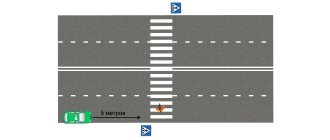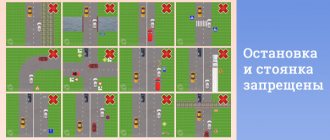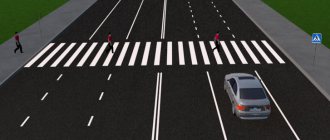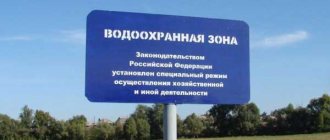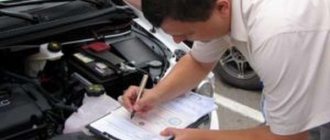Stopping near the crossing in the oncoming lane
Traffic rules allow stopping in the oncoming lane.
On the left side of the road, stopping and parking are permitted in populated areas on roads with one lane for each direction without tram tracks in the middle and on one-way roads (trucks with a permissible maximum weight of more than 3.5 tons are allowed on the left side of one-way roads only stopping for loading or unloading).
Here you need to understand that the physical location of the car does not matter. The direction of movement along the roadway is important. The vehicle must not block the view of approaching vehicles.
Stop near a pedestrian crossing in the oncoming lane.
When stopping in the oncoming lane on the driver's side, the rules are reversed. In the oncoming lane, stopping within 5 meters of a pedestrian crossing is prohibited. And this is again if a solid marking line advises against it. If there are continuous markings on a two-lane road, stopping is prohibited at a distance of almost 23 meters on both sides of the pedestrian crossing.
Stop near a pedestrian crossing in the oncoming lane with markings.
Being in the oncoming lane to the left of a continuous marking is a more serious violation with possible deprivation of the right to drive.
Is it possible to undergo a medical examination for a license outside of your place of registration?
Hand over for recycling
Car recycling price
Validity period of a medical certificate for a license
Statement of claim for compensation for damage caused by an accident (traffic accident)
How much does a medical examination cost?
What questions does a psychiatrist ask during a medical examination for a license?
Documents for the driver's medical examination
- home
- >
- Parking
- >
- Parking in front of the pedestrian crossing
Parking in front of a pedestrian crossing is permitted subject to traffic regulations. It is necessary to maintain distance so as not to create emergency situations for cars and people.
Dear readers! The article talks about typical ways to resolve legal issues, but each case is individual. If you want to find out how to solve your particular problem , contact a consultant:
+7 (Saint Petersburg)
APPLICATIONS AND CALLS ARE ACCEPTED 24/7 and 7 days a week.
It's fast and FREE !
Violation of parking rules is fraught with administrative liability.
It is forbidden to leave the car at the pedestrian crossing itself, i.e. on the zebra crossing. The term parking (parking) implies that the driver leaves the car for more than 5 minutes . If the car remains on the roadway for less time, then it is a stop. It involves boarding, disembarking passengers, loading, unloading.
You can avoid breaking the law (Administrative Code of the Russian Federation - Article 12.19) if:
- choose the right parking space;
- adhere to the stop meter. It is measured from the pedestrian crossing (sign) to the car;
- do not block the path or otherwise interfere with other road users.
If you violate the rules of stopping or parking (parking), the driver will be punished.
The exception is cases when stopping a car with traffic violations is caused by a malfunction of the car or poor health of the driver or his passengers.
If the car breaks down, you need to push and roll it to a safe place, put up an emergency sign and turn on the hazard lights. If the rules are followed, the driver will avoid an administrative fine.
Stopping near the crossing on the side of the road
General stopping rules require drivers to first stop on the side of the road, if available.
12.1. Stopping and parking of vehicles is permitted on the right side of the road on the side of the road, and in its absence - on the roadway at its edge...
How to stop if there is a pedestrian crossing on such a road?
Car #1
The car is parked in front of a pedestrian crossing, the distance is more than 5 meters, there are obviously no violations of the Traffic Rules. It's simple.
Car #2
Here we already see a violation of traffic rules, the question is in its qualifications.
Stopping is prohibited: in places where the vehicle... will interfere with the movement of pedestrians...;
Yes, it is this point of the rules that is violated by car No. 2, and not the prohibition of stopping at a pedestrian crossing. Why? More on this further with car #3.
Car #3
The situation with this car is controversial. From the definition of “Pedestrian crossing” it follows that a pedestrian crossing is a section of the roadway and formally there is no crossing in front of this car, it is on the roadway, and the car is on the side of the road to the right of it. The shoulder continues in front of the car.
On the other hand, the prohibition of stopping before crossing is due to the visibility of moving cars by pedestrians and to providing an overview of the road before entering the roadway. The car blocks this view. It would be correct to assume that the rules were violated, if only because such a stop directly affects the safety of the crossing.
Leave the vehicle behind the crossing: yes or no?
To answer this question, you need to clearly understand all the concepts associated with it. Thus, a pedestrian crossing is a certain area along which pedestrian traffic participants move. Moreover, the transition zone is much wider than the well-known striped designation: the boundaries are determined by markings or symbols.
It is worth noting that the traffic rules do not contain the concept of parking. The borrowed word has a Russian analogue - parking.
It is this term that appears in the law and implies the following features:
- the motorist stopped his vehicle on purpose;
- the parking duration is always more than 5 minutes (otherwise the driver only makes a stop);
- parking cannot be caused by the need for loading operations or the entry/exit of people;
- the car is idle only in specially designated areas;
- the vehicle occupies the position prescribed by the rules (parallel or in another manner indicated by the sign).
Current legislation does not prohibit drivers from leaving vehicles immediately behind a pedestrian. This is explained by the fact that parking immediately behind the sign will not lead to increased public danger: the car does not block the view. Consequently, there is no threat to the life and health of pedestrian traffic participants. In this case, the distance from the parking lot to the zone is not taken into account.
What to remember when parking
The provisions of the 12 current traffic rules fix all the norms for stopping or parking. The main principle of existing rules is to ensure a clear view of moving motorists. Otherwise, approaching car owners will not notice people at the beginning of the crossing, which can lead to serious consequences.
Pedestrians are usually less likely than drivers to think about the possibility of an accident and appear at the crossing suddenly. Due to inattention (his own or that of a pedestrian participant), a motorist may not have time to slow down.
To avoid accidents, you must follow the following rules:
- Traffic participants cannot leave any vehicles at the checkpoint;
- the car owner must maintain a distance of at least 5 meters;
- parking, subject to safety conditions, can only be done in the absence of prohibitory signs;
- the car owner does not have the right to run over the markings when stopping;
- The driver must not interfere with other motorists.
The last point is usually violated. There are certain common cases of violation. For example, a driver can leave the car in close proximity to a continuous marking so that it will be possible to go around it only by hitting a continuous marking. This is a gross violation. There must be at least 3 meters between the car and the solid road.
We must not forget that on the right side the driver must stop 5 meters before the crossing, and on the left - after. We also accept the option of changing lanes to the left and immediately stopping traffic (the main thing is not to drive into the zone itself). The view of oncoming traffic is not blocked - the driver can safely leave the car.
Where you can and cannot stop and leave your car
Stopping and parking (Chapter 12 of traffic rules) are allowed:
- On the side of the road on the right side. If it is not there, then it is on the roadway, closer to the edge.
- Is it possible to park on the opposite side of the road against traffic? On the left side of the road, parking and stopping are permitted in built-up areas on roads with one lane for each direction without tram tracks in the middle and on one-way roads.
- The car is placed in one row parallel to the edge of the roadway. Two-wheeled vehicles without a trailer can be parked in two rows.
- If the driver wants to stop for a long rest, then this is permissible outside the populated area in areas specially provided for this or off the road.
The method of stopping a car or parking is determined by sign 6.4. When a sign is combined with plates 8.6.4-8.6.9 and road marking lines, parking a vehicle is permitted at an angle to the edge of the roadway if the space allows such an arrangement.
Is parking allowed on the sidewalk? It is necessary to separate the concepts of “sidewalk” and “roadside”. A sidewalk is a space for pedestrian movement, separated from the road by a curb, lawn or green plantings.
You cannot park on the sidewalk, otherwise you may get a fine. The car may also be towed. Shoulder is a part of the road that is at the same level and is not separated by curbs or grass. It stands out with special markings. Parking is allowed there.
Parking on the sidewalk can be justified if there are technical malfunctions of the car or force majeure circumstances. They must be documented.
Violation of this rule is regulated by Article 12.9 of the Code of Administrative Offenses of the Russian Federation, paragraph 3. The fine is 1000 rubles.
Regarding permissible distances
Let's briefly answer the most common questions:
| How many meters before the stop can I park? | The distance is at least 15 meters to the stop of route vehicles and taxis. |
| How many meters before the intersection can I park? | The distance must be at least 5 meters to an intersection or pedestrian crossing. |
| How many meters before the pedestrian crossing can I park? | The distance should be 5 meters, no closer. |
How far from the turn can you stop your car? If visibility on road sections is less than 100 m, you should not stop the car before dangerous turns.
How to count 5 meters?
In the actual traffic rules there is no clear indication of where a motorist should calculate a distance of 5 meters. There is only an order - to the object. Therefore, it is necessary to highlight the boundaries of the pedestrian zone. The Rules interpret this information quite clearly.
The crossing is an area separated by special signs (5.19.1 and 5.19.2) and/or marking lines (1.14.1 and 1.14.2) and equipped with special markings in the form of stripes on the road.
If a given area does not have markings, the boundaries of the zone are determined by posted signs:
- Sign 5.19.1 is a square blue-colored plate located to the right of the PCH and indicating the beginning of the zone separated for pedestrians. The motorist can park his vehicle only 5 meters before this landmark.
- Sign 5.19.2 is similar to the previous sign. The only difference is that this sign is installed to the left of the roadway: it informs about the end of the pedestrian zone.
If there is a marking on a pedestrian, the boundary of the zone is determined precisely by its instructions. The driver can be guided by the following logic:
- There is a marking line - the required distance is counted before marking begins.
- There are no markings - the distance is counted to the sign indicating the beginning of the pedestrian section.
But how to measure exactly 5 meters? No way. The only way not to make a mistake is to park significantly further from the pedestrian. In cases of doubt that there will be 5 meters in front of the car, it is better to refrain from stopping.
A road service employee will always have a distance measuring device. The inspector will prove the motorist's guilt by measuring it. At the same time, the driver’s inability to accurately estimate the distance is not a justification for canceling the fine.
How not to make a mistake when choosing a parking spot
Parking takes more than 5 minutes, and stopping does not imply a long cessation of traffic. The only exception is the need for loading and unloading operations or boarding/disembarking people - even if it lasts more than 5 minutes, this is a stop.
The following situations can be called a stop:
- the driver stopped the car for 4 minutes 59 seconds (the purpose of the stop is not important);
- the motorist stopped to unload furniture from the vehicle (the process can last at least 6 minutes, at least 60);
- people need to be dropped off (even if the elderly person took 7 minutes to get off, the driver still made a stop and not a parking lot).
Therefore, if the owner of the vehicle stopped moving and got out of the car just to stand for 15 minutes, he has parked. If he took a folding chair out of the trunk, sat down for the same time and then loaded the object back into the car, a stop was made. This technique is used by drivers when there is a parking prohibited sign - they imitate the loading process, pulling objects out of the car and “plunging” them inside again.
It is important to pay attention to the legal requirements. Thus, stopping will be illegal if there is a prohibiting sign.
You may also not stop in the following areas:
- tram rail tracks;
- railway zones;
- bridges and under them;
- at the intersections of PCH;
- overpasses;
- 5 meters before the pedestrian;
- in areas characterized by increased danger (for example, before a sharp turn);
- in the cycling zone;
- tunnels;
- 15 meters away from a public vehicle stop (an exception is provided for disembarking people, but drivers of buses and other similar vehicles should not experience inconvenience);
- in places where stopping will disturb other people (you cannot leave your car while blocking signs or other important elements);
- 5 meters before the edge of the inverter;
- closer than 3 meters to the solid.
Parking in these areas is also prohibited. However, if you want to leave the car for a long time, the owner of the vehicle must take into account two more restrictions:
- you cannot leave your car on the main road;
- It is prohibited to park in the area covered by the “Settlement” sign without maintaining a distance of 50 meters from the railway.
Otherwise, the motorist will face negative sanctions from inspectors.
